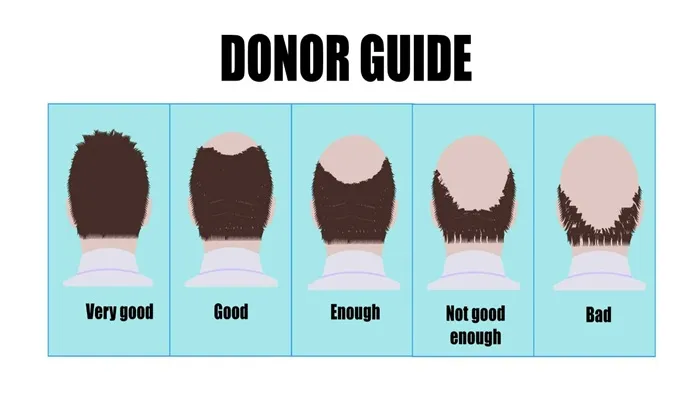Hair transplant surgery is a delicate procedure that requires careful aftercare to ensure proper healing and optimal results. One of the most common questions patients have is when they can cut their donor area hair after the procedure. Understanding the healing process and following proper aftercare instructions are crucial for ensuring the best possible outcomes. This article will provide a detailed guide on when and how you can cut your donor area hair after a hair transplant.
Understanding the Healing Process
Immediate Post-Op Period (First Few Days)
After the transplant, the donor area will have tiny incisions where the hair follicles were extracted. These areas may be covered with scabs. Hair health is sensitive during this time, and any unnecessary irritation can damage the healing process. For the first 3 to 5 days, the donor area will be inflamed and tender, requiring extra care.
What to do
- Avoid any direct contact or pressure on the donor area.
- Do not wash your hair vigorously, as this can disturb the healing incisions.
- Refrain from cutting your hair or trimming it, as it can hinder the healing process.
Scab Formation and Healing (Week 1 to 2)
Within the first two weeks after the procedure, the scabs in the donor area will begin to fall off naturally. At this stage, your scalp might feel itchy, but it’s crucial to resist scratching or rubbing the area, as this can lead to scarring or damage to the hair follicles.
New Hair Growth (1 to 3 Months)
As healing continues, you may notice the new hair follicles in the transplant area starting to grow. This can be a delicate period for your hairline and the donor area, as the hair growth process will vary from person to person. The donor area will typically be fully healed by the end of the third month.
Full Recovery (6 to 12 Months)
Within 6 to 12 months after the transplant, the hair in both the donor and recipient areas should show significant growth. The donor area will be fully healed, and any signs of scarring will be minimal. However, it’s important to note that the exact timeline for recovery can vary from one patient to another, depending on factors such as skin type, age, and overall hair health.
Factors Affecting the Timing of Cutting the Donor Area
Type of Hair Transplant Technique
As mentioned earlier, FUT and FUE have different healing processes. FUT, being a more invasive procedure, generally requires a longer waiting period before cutting the donor area. The linear scar in FUT takes more time to heal compared to the small puncture wounds in FUE.
Individual Healing Ability
Each person’s body heals at a different rate. Factors such as age, overall health, and genetics can influence the healing process. Younger, healthier individuals may be able to cut the donor area earlier than those with underlying health conditions or slower healing processes.
Post – Operative Care
Proper post – operative care can significantly impact the healing process. Patients who follow the surgeon’s instructions regarding scalp cleaning, medication, and activity restrictions are more likely to heal faster and be able to cut the donor area earlier.
Nature of the Haircut
The type of haircut also plays a role. A simple trim that only involves cutting the ends of the hair is less likely to cause damage to the follicles compared to a more drastic haircut that involves shaving the head or cutting the hair very short.
Tips for Cutting the Donor Area After Hair Transplant
Consult Your Surgeon
Before cutting the hair in the donor area, always consult your hair transplant surgeon. They can provide personalized advice based on your specific case, including the best time to cut the hair and any precautions you should take.
Choose a Skilled Hairstylist
Select a hairstylist who is experienced in working with patients who have had hair transplants. They will be more aware of the sensitivity of the scalp and the need to handle the hair gently.
Be Clear About Your Expectations
Communicate your desired haircut to the hairstylist, but also be clear about the fact that you’ve had a hair transplant. This will help the hairstylist choose the right techniques and tools.
Monitor Your Scalp
After the haircut, monitor your scalp for any signs of discomfort, redness, or swelling. If you notice any issues, contact your surgeon immediately.
Conclusion
In conclusion, the general guideline for cutting your donor hair after a hair transplant is to wait until at least 10 to 14 days post-surgery. However, individual healing times vary, and it’s always best to consult with your surgeon to get personalized advice. The donor area will be fully healed within 3 to 6 months, allowing you to return to your usual grooming routine without concern. By taking care of your hair health and following your surgeon’s instructions, you can ensure that your hair transplant provides the best possible results.
By waiting for the appropriate time and following these tips, you’ll protect both your donor and recipient areas, leading to a fuller, healthier head of hair. Whether you’re addressing hair loss or reshaping your hairline, proper aftercare is essential for achieving long-lasting and satisfying results from your hair transplant.
Related topics:
- When Can I Cut My Donor Area After a Hair Transplant?
- When Can You Shave Donor Area After Hair Transplant?
- Hair Transplant Donor Area Before and After: What to Expect


